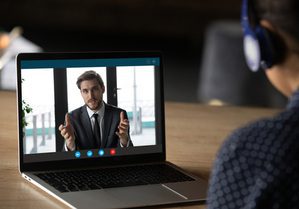86% of organizations incorporated new technology to interview job candidates due to the COVID-19 pandemic. Many talent professionals agree that virtual recruiting will continue post-coronavirus. This evidence seems to suggest that organizations will keep embracing technology as a competitive advantage when it comes to interviewing.
Virtual interviews offer benefits to both organizations and job seekers. Employers get access to an expanded talent pool, while candidates get to consider more employment opportunities than ever before. This article is designed to guide employers through the virtual interview process and how to secure top talent.
Best Practices
Employers should follow a general, overarching timeline to streamline the virtual interview and hiring processes. With this in mind, employers should consider the following tips for conducting successful virtual interviews:
- Set clear expectations. Make sure candidates have all the information they’ll need—such as technology requirements, log-in information and an agenda. Also, let the candidate know if the format is one-on-one or panel interview.
- Properly use technology. Plan ahead to ensure video and audio technology is working smoothly. It’s important to double-check all interview technology and ask candidates to do the same. Properly using and troubleshooting technology can reflect well on an organization’s brand.
- Establish professionalism. Treat a virtual interview with the same level of professionalism and respect as an in-person interview. This includes setting the appropriate tone, dialogue and dress expectations for all parties involved.
The Challenges
As with any process shift, there are some challenges for employers to overcome. First, organizations will need to build or refine their virtual processes. This includes incorporating personal touches into the virtual interview process. For example, some hiring managers may not be used to evaluating candidates over video. As such, employers should help make them comfortable and provide training resources on this topic.
Employers should also decide when and how to use virtual interviews or in-person interviews, as well as how to optimize the candidate experience.
The Benefits
Whether virtual or not, it’s critical for employers to have strong interview processes in place. Virtual interviews can provide benefits for both employers and candidates, such as the following:
- Cost-efficient operations
- Geographically diverse candidate pipelines
- Consistent processes
- Flexible and convenient schedules
- Shortened time-to-hire cycles
Virtual interviewing is a great way for an employer to showcase to potential hires that their organization is agile and embracing modern recruiting solutions.
Types of Virtual Interviews
There’s no one-size-fits-all approach for the interview process, so hiring managers should consider using different interview types, channels and structures to achieve their desired outcomes.
While the hiring process typically starts with a candidate submitting a resume or job application, employers should consider how to best use virtual interviews as candidates progress in the hiring cycle.
A screening interview is typically the first connection during the hiring process. While interview processes vary, a screening interview is often used to assess a candidate’s fit and interest for a position, or to discuss the candidate’s qualifications in more detail. Notably, if the position requires phone and video use or good verbal communication skills, a screening interview can be helpful to determine whether the candidate has those soft skills or not.
A selection interview tends to be more rigorous and typically determines if a candidate can move along in the hiring process or whether they’ll receive a job offer. A selection interview—which is sometimes the final interview—is where most employers use video technology. Clearly, employers have much to consider when designing or evaluating their company-wide interviewing processes.
Channel and Technology Considerations
Employers also have various options for conducting virtual interviews—including via phone, live chat (e.g., chat-based messaging apps) or video technology (e.g., Skype, Zoom or Microsoft Teams). Live chat tools can streamline early-stage interviews, and are typically most popular among millennials and Generation Z candidates. If using video technology, employers should choose a process and video platform that will work best for them and their candidates.
It’s important for employers to protect the personal information of candidates during virtual interview processes. That being said, cybersecurity is a major technology implication to be aware of. For example, employers should ensure video interviews fall within their internal guidelines for cybersecurity, as well as any related policies.
Once HR professionals or hiring managers decide on the type of interview and technology that will be used, it’s important for employers to be consistent in their interview processes with each candidate who applies for the same position.
As with any type of interview, it’s important for employers to be prepared and set expectations.
Material posted on this website is for informational purposes only and does not constitute a legal opinion or medical advice. Contact your legal representative or medical professional for information specific to your legal or medical needs.




